Blue Hills Reservation
| Blue Hills Reservation | |
| Massachusetts State Park | |
 Ponkapoag Pond, with Great Blue Hill visible in the background | |
| Country | United States |
|---|---|
| State | Massachusetts |
| County | Norfolk |
| Elevation | 180 ft (55 m) [1] |
| Coordinates | 42°12′40″N 71°07′40″W / 42.21111°N 71.12778°WCoordinates: 42°12′40″N 71°07′40″W / 42.21111°N 71.12778°W [1] |
| Highest point | Great Blue Hill |
| - elevation | 635 ft (194 m) |
| - coordinates | 42°12′43″N 71°06′56″W / 42.21194°N 71.11556°W [2] |
| Area | 6,195 acres (2,507 ha) [3] |
| Established | 1893 |
| Management | Massachusetts Department of Conservation and Recreation |
| - location | Headquarters: 695 Hillside St, Milton |
| - coordinates | 42°12′32.6″N 71°06′8.3″W / 42.209056°N 71.102306°W |
| Nearest city | Milton, Massachusetts |
| Public transit | MBTA bus 238, 240 |
|
Location in Massachusetts | |
| Website: Blue Hills Reservation | |
Blue Hills Reservation is a 6,000-acre (2,400 ha) state park in Norfolk County, Massachusetts. Managed by the Massachusetts Department of Conservation and Recreation, it covers parts of Milton, Quincy, Braintree, Canton, Randolph, and Dedham. Located approximately ten miles south of downtown Boston, the reservation is one of the largest parcels of undeveloped conservation land within the metropolitan area. The park's varied terrain and scenic views make it a popular destination for hikers from the Boston area.[4]
History
European explorers sailing the coastline noticed the bluish hue of the mountains, which is caused by the presence of riebeckite,[5] which gave area its modern name.[4] The name of the state of Massachusetts derives from the Massachusett Indian tribe's name of the hill: massa-adchu-es-et.[6] In 1893, the Metropolitan Parks Commission purchased the lands of Blue Hills Reservation as one of the state's first areas dedicated to public recreation.[4]
The practice of First Day Hikes to mark New Year's Day with an outdoor activity began in 1992 at Blue Hills Reservation.[7] By the 2010s, the idea had spread and such hikes were taking place in state parks nationwide.[7]
Flora and fauna
The ecology of the Blue Hills is diverse and includes marshes, swamps, upland and bottomland forests, meadows, and an Atlantic white cedar bog. A number of endangered species in Massachusetts, such as the timber rattlesnake, reside in the reservation. Other flora and fauna include dogwood, lady's slipper, white-tailed deer, coyotes, wild turkey, red fox, turkey vultures, and copperheads.[4]
Points of interest
Observatory
The highest point within the reservation, Great Blue Hill in Milton, is the site of the historic Blue Hill Meteorological Observatory. The observatory was founded in 1885 and is the oldest continuous weather recording station in the United States.[8] Its tower offers views of Boston and the surrounding area. The tower and observatory are among numerous reservation features listed on the National Register of Historic Places.
Features listed on the National Register of Historic Places
| Name | Location | Image | Remarks |
|---|---|---|---|
| Blue Hills State Police Station H-7 | Hillside Street, Milton | 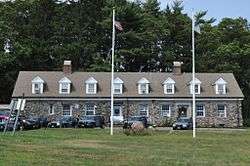 |
|
| Blue Hills Reservation Parkways | Milton, Quincy, Braintree, Canton | ||
| Brookwood Farm | Hillside Street, Milton | ||
| Chickatawbut Observation Tower | Chickatawbut Road, Quincy | 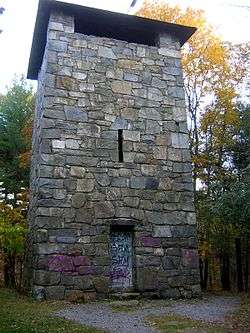 |
|
| Comfort Station | Blue Hill Avenue, Milton | 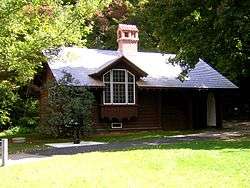 |
|
| Eliot Memorial Bridge | Milton | ||
| Great Blue Hill Observation Tower | Milton | 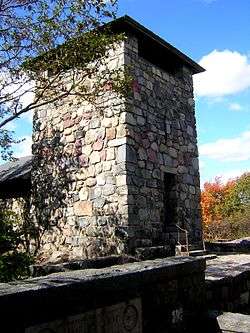 |
|
| Great Blue Hill Weather Observatory | Milton | ||
| Massachusetts Hornfels-Braintree Slate Quarry | Milton | 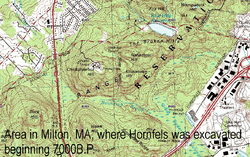 |
|
| Metropolitan District Commission Stable | Hillside Street, Milton | 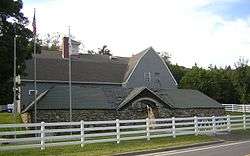 |
|
| Old Barn | Blue Hill River Road, Canton | ||
| Ponkapoag Camp of Appalachian Mountain Club | Randolph |  |
|
| Refreshment Pavilion | Hillside Street, Milton | ||
Blue Hills Trailside Museum
The Blue Hills Trailside Museum, which is affiliated with the Massachusetts Audubon Society, offers indoor and outdoor animal exhibits.[9]
Activities and amenities
Blue Hills Reservation is primarily used for hiking and mountain biking. It is also used for snowshoeing, downhill skiing, and cross country skiing during winter, and rock climbing (in certain areas) and horseback riding during permissible months. Between approximately December and March, Great Blue Hill offers a ski area. Houghton's Pond and nearby Ponkapoag Pond are popular swimming and recreation areas during the summer. Other recreational opportunities include non-motorized boating, camping, fishing, picnicking, playing fields, ice skating, and interpretive programs.
References
- 1 2 "Blue Hills Reservation". Geographic Names Information System. United States Geological Survey.
- ↑ "Great Blue Hill". Geographic Names Information System. United States Geological Survey.
- ↑ "2012 Acreage Listing" (PDF). Department of Conservation and Recreation. April 2012. Retrieved January 19, 2014.
- 1 2 3 4 "Blue Hills Reservation". MassParks. Executive Office of Energy and Environmental Affairs. Retrieved January 31, 2014.
- ↑ Les Tyrala. "The Hard Truth: The Geology of the Blue Hills" (PDF). Friends of the Blue Hills. Retrieved January 31, 2014.
- ↑ William Wallace Tooker (1904). "Algonquian Names of Some Mountains and Hills". The Journal of American Folk-Lore. XVII: 175. Retrieved August 4, 2015.
- 1 2 Scheible, Sue (January 2, 2016). "Braintree man honored for starting national First Day hikes". The Patriot Ledger. Quincy, Massachusetts.
- ↑ "History". Blue Hill Observatory. Retrieved January 31, 2014.
- ↑ "Blue Hills Trailside Museum". MassAudubon. Retrieved January 31, 2014.
External links
| Wikimedia Commons has media related to Blue Hills Reservation. |
- Blue Hills Reservation Department of Conservation and Recreation
- Friends of the Blue Hills
- Blue Hill Observatory HazeCam Current panoramic photo from observatory
- Online (mobile compatible) trail map